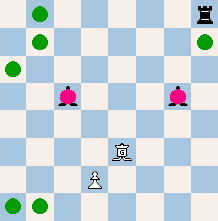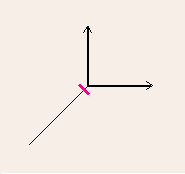

The Gaul is a bifurcation piece. It captures like a bishop, but makes non-capturing moves in two legs, by leaping diagonally over an intervening piece and temporarily land on the empty square immediately behind the piece. From there it slides like a rook on any of the two orthogonals in the prolonged movement direction. The Gaul's value is 3, that is, the same as a bishop or knight (preliminary estimate). The Gaul is dependent on 'screens' for moving, but as it can capture directly on the diagonals it can have a positional influence also when it's unable to make non-capturing moves. Other rules are the same as in standard chess, except for the possible promotion to Gaul. Gaul Chess can also be played with Kwaggas instead of knights. Gaul Chess, and the new Gaul piece, were invented by undersigned, October 2006.
The Gaul was an early gladiator type in ancient Rome that used the weapons and equipment characteristic of the Gaul people.
 The Gaul can move in two legs, the first is a diagonal slide followed by a jump, and the second is an orthogonal slide. Capturing occurs diagonally on the first leg (red = capture).
The Gaul can move in two legs, the first is a diagonal slide followed by a jump, and the second is an orthogonal slide. Capturing occurs diagonally on the first leg (red = capture).
 The Gaul's movement principle. The screens, that are used for leaping, occur anywhere on the first leg. Should the screen be an enemy piece it can be captured.
The Gaul's movement principle. The screens, that are used for leaping, occur anywhere on the first leg. Should the screen be an enemy piece it can be captured.
• You can download my free Gaul Chess program here (updated 2007-02-23), but you must own the software Zillions of Games to be able to run it.
• Don't miss my other chess variants.
© M. Winther (October 2006).